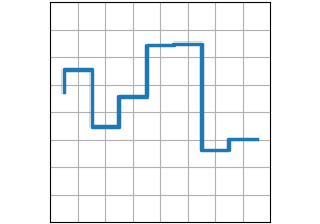matplotlib.axes.Axes.step¶
- Axes.step(x, y, *args, where='pre', data=None, **kwargs)[source]¶
Make a step plot.
Call signatures:
step(x, y, [fmt], *, data=None, where='pre', **kwargs) step(x, y, [fmt], x2, y2, [fmt2], ..., *, where='pre', **kwargs)
This is just a thin wrapper around
plotwhich changes some formatting options. Most of the concepts and parameters of plot can be used here as well.Note
This method uses a standard plot with a step drawstyle: The x values are the reference positions and steps extend left/right/both directions depending on where.
For the common case where you know the values and edges of the steps, use
stairsinstead.- Parameters
- xarray-like
1D sequence of x positions. It is assumed, but not checked, that it is uniformly increasing.
- yarray-like
1D sequence of y levels.
- fmtstr, optional
A format string, e.g. 'g' for a green line. See
plotfor a more detailed description.Note: While full format strings are accepted, it is recommended to only specify the color. Line styles are currently ignored (use the keyword argument linestyle instead). Markers are accepted and plotted on the given positions, however, this is a rarely needed feature for step plots.
- where{'pre', 'post', 'mid'}, default: 'pre'
Define where the steps should be placed:
'pre': The y value is continued constantly to the left from every x position, i.e. the interval
(x[i-1], x[i]]has the valuey[i].'post': The y value is continued constantly to the right from every x position, i.e. the interval
[x[i], x[i+1])has the valuey[i].'mid': Steps occur half-way between the x positions.
- dataindexable object, optional
An object with labelled data. If given, provide the label names to plot in x and y.
- **kwargs
Additional parameters are the same as those for
plot.
- Returns
- list of
Line2D Objects representing the plotted data.
- list of
